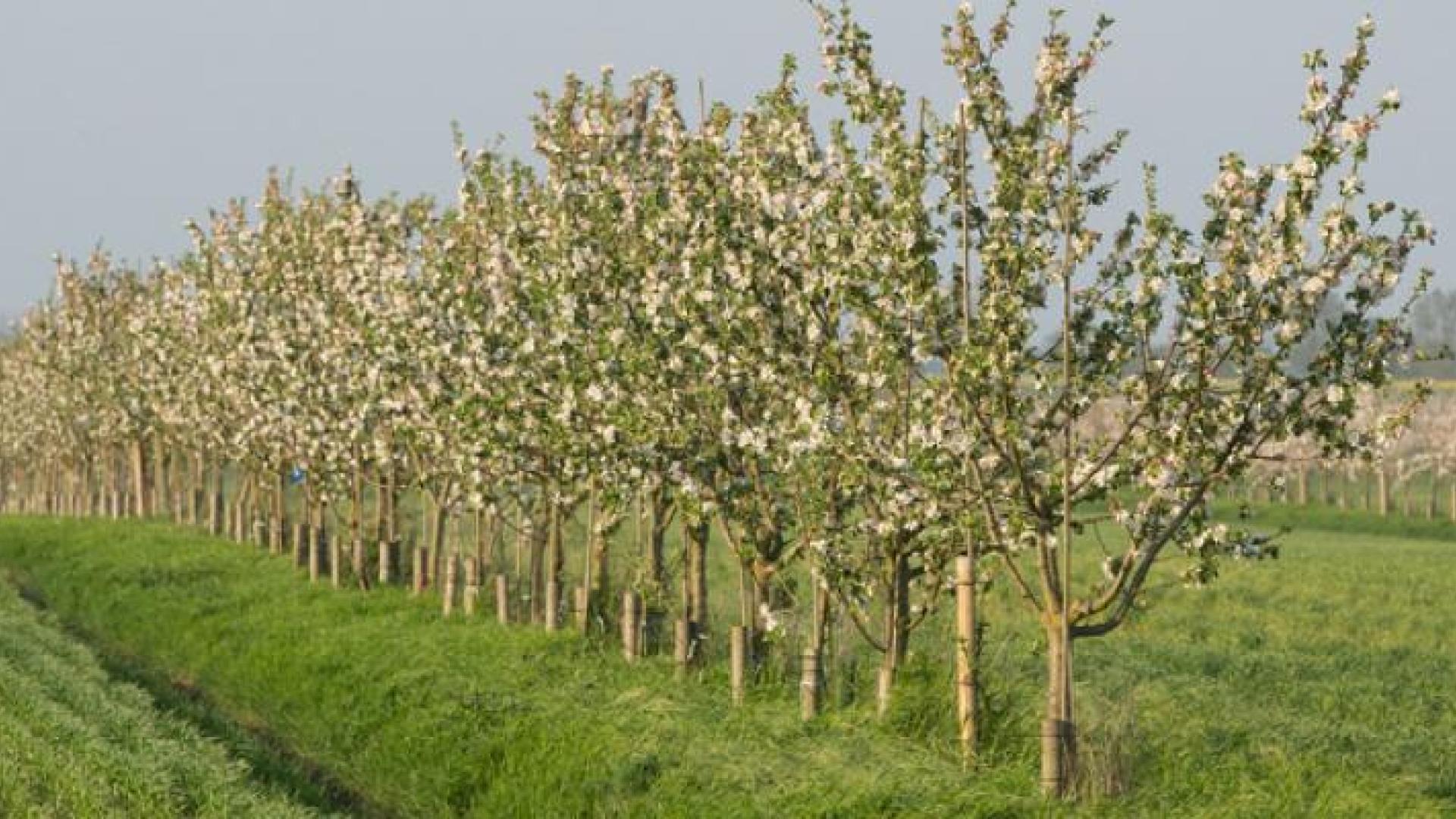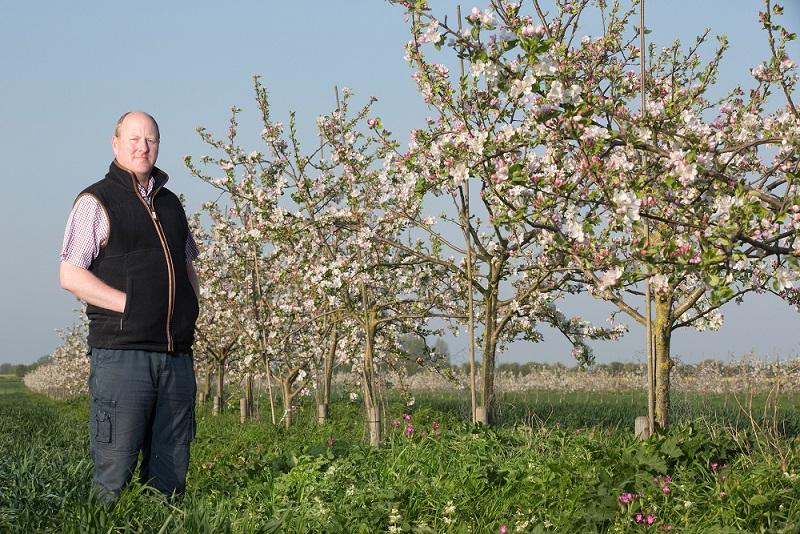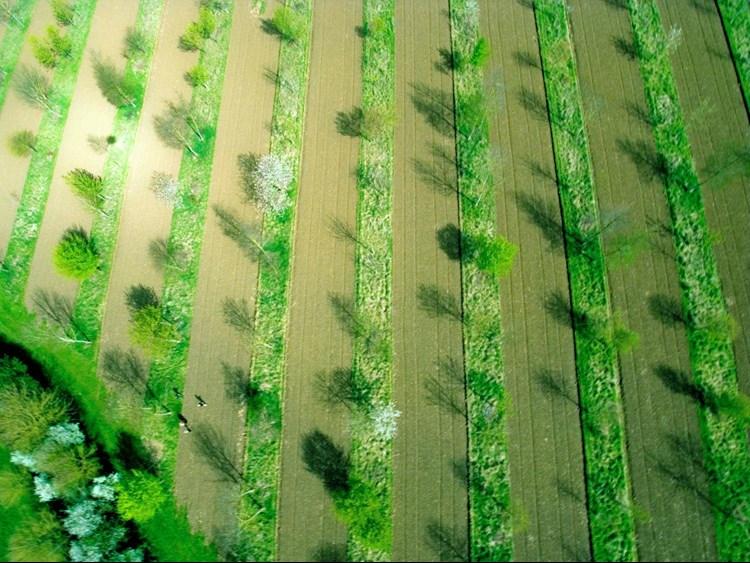Sandra Bell17 Dec 2019
From sucking up carbon to providing a home for wildlife there are many reasons for planting more trees. But can planting more trees on farms help reduce pests and diseases, boost natural pest control and cut the need for pesticides?
How can trees help cut pesticides?
Evidence is mounting that overuse of pesticides is a key driver of biodiversity loss – linked to harm to much of our precious wildlife including bees, birds, and hedgehogs. In the second in a series of blogs about innovative ways to cut pesticide use1, I look at exciting new evidence that trees can play a role in pest control.
The most sustainable way of keeping pests and diseases under control is to use agroecological methods to prevent the build-up of problems then work with nature to keep pests and predators in balance. That means providing diverse habitats to help boost the services that nature provides to farming. Natural pest control is thought to be better on farms with trees because the trees start to replicate the kind of insect diversity found in a woodland. Pests become better controlled when key predators are present.
Agroforestry farmer Stephen Briggs certainly believes this to be the case. “Nature doesn’t do monoculture – a farming system where the vegetation cover is varied, and includes trees and understory, has more natural checks and balances built in, and is more resilient than the simplified systems that dominate much of the farmed landscape”.
It seems that farmers and researchers alike are increasingly convinced that there’s a beneficial role for trees in boosting natural predators with an important study concluding that “Because trees are larger, live longer, and have a greater variety of tissues and structures than herbaceous plants, they can provide niches for a wide range of organisms.”2
Innovation building on tradition
Although the term agroforestry was only coined in the 1970s, the practice of maintaining or integrating trees in the agricultural landscape has existed from ancient times and around the world.
The UN’s Food and Agriculture Organisation lists reduction in the need for pesticides among the benefits of agroforestry3, but warns “In the last centuries however farming and trees became dissociated as monocropping became more common, in order to intensify food production”. Research has found that agroforestry is particularly beneficial in terms of pest, disease and weed management in coffee and cocoa crops,4 indicating that we should be reintroducing this approach widely.
I wanted to find out if similar evidence exists in the UK.
New trials are promising
I was pleased to find that new research was looking into this. Recent trials have been taking place on several UK arable farms to measure the pest control and pollination benefits of agroforestry, and to develop knowledge about how to optimise these services to farmers.
The trials (run by Woodland Trusts and University of Reading) found most pests, including pollen beetles in oilseed rape and root flies, were less abundant on farms with trees. Natural predators and pollinators increased5.
It’s been pleasing to have the science confirming what I believed – that the trees on my farm are making a positive difference to pest control, with more beneficial insects such as spiders and ladybirds and less pests.
Stephen Briggs, a farmer involved in the University of Reading trials
Farmer Stephen Briggs believes that in agroforestry systems beneficial insects are distributed more widely across the farmed area, increasing the benefit. He describes adding trees as a step up from providing other kinds of habitat and says that the trees and understory on his farm act like “turbocharged beetle banks”
The trials are the latest in a promising series of studies.
Building on a basis of evidence
A comprehensive review of evidence in temperate silvoarable systems (planting trees with cereal crops in rows or at field edges) found that pest populations (excluding slugs) were reduced by 25% on average, while their natural predators increased by 24%, compared with just arable6. Predatory spiders and parasitic wasps are both effective pest controllers and were found to be abundant in an experimental silvoarable system at the University of Leeds7.
Hedges on farms could also be another way to boost pest control. In California, research found that a new hedge paid for itself in terms of insecticide savings in 16 years, and only 7 years if benefits of pollinators were included8. Another study of hedges found crop-pest levels were reduced over distances of at least 60 m from the hedge9.
Maximising the benefits of diversity
Trials on farms are important because they can help to improve practical advice to farmers on how the design and management of agroforestry systems can maximise the benefits from nature.
For example, I wondered whether the diversity of trees planted on a farm would make a difference. Tom Staton, the lead researcher from University of Reading, thinks it might: “We can learn from studies of hedgerows and field margins, and there’s good evidence that plant diversity improves natural pest control, so yes I’d expect the mix of trees to make some difference. Another important aspect could be the vegetation below the trees, in terms of plant diversity and its management”.
Do more trees deliver greater benefit?
There could be additional benefits if more farms took up agroforestry systems and increased total tree cover across the landscape.
This could have benefits for highly mobile predators like ground beetles, which can move up to 43 metres in a day. Small-scale agroforestry doesn’t seem to boost ground beetles, but Tom Staton believes that if agroforestry was planted across the landscape, we’d expect to see a benefit compared to large open fields, especially conventionally managed ones that don’t use an organic or agroecological system. This would be a similar effect to the way adding beetle banks makes a bigger difference in larger fields, by adding habitat to a large cropped area.
Dealing with slugs
The University of Reading trials and earlier studies found some evidence of more slugs in agroforestry. However, this may not be a threat to crops − in the recent trials this was only apparent in the spring, with little difference in autumn when the newly sown crops are most vulnerable to slug damage.
Where slugs are a problem, different management could make all the difference, as Tom Staton explains: “We know from other studies that slugs generally prefer a tall, diverse plant community, and so we’re testing whether regular cutting of the tree-row understorey could help to suppress slugs. We might expect this to benefit weed control too. However, regular cutting could also suppress the beneficial insects by reducing floral resources, so we’ll also be monitoring these to investigate trade-offs"
Slugs were not a problem on all farms. Stephen Briggs has his slugs under control – which is a testament to the long-term agroecological management of his farm – with predators and pests in equilibrium.
Spreading the word
Innovative farmers are already leading the way in agroforestry design and management. Rolling out their experiences more widely – using existing farms as demonstration sites – would help to give other farmers confidence that well sited and well managed trees and understory can help with pest management on their farms.
Helen Cheshire from the Woodland Trust, who was also involved in the trials, believes this approach will be a motivation for some farmers: “Being able to cut inputs and boost natural predators via agroforestry is important for arable farmers, but it’s unlikely to be the only or primary reason for adding in trees. However, as the only conventional farmer in the study, David Rose’s primary objectives did include wanting to see a direct reduction in pesticide use.”
Developing the evidence
The evidence on the benefits of trees is already looking good. But we can always increase our knowledge. Tom Staton thinks that focusing research on the effectiveness of pest control and pollination for fruit production in agroforestry would be a good aim. Fruit trees are likely to be particularly appealing to arable farmers, due to their potential for a relatively rapid return on investment by adding another crop to the farm.
We need more trees – how can more farmers be persuaded to plant them?
Committing to an agroforestry system would require a big investment by farmers and a big change to what arable farmers are used to. Helen Cheshire told me that the capital required to plant trees on farms and the difficulty of accessing good advice can be key barriers. Where the Woodland Trust has been able to provide free advice to farmers it’s made a difference, but this needs to be scaled up.
Pledges to plant more trees were high profile in during the general election. We now need firm government plans that help farmers plant trees. The promised new Environmental Land Management Scheme should stick to the proposal to reward public goods. Although it remains unclear how this will work and what will be rewarded, planting the right trees in the right place in the farmed landscape must surely qualify for the multiple benefits it will deliver.
The scheme will also need to recognise the need for initial capital investment in tree planting on farms. The important role of guidance – and especially opportunities for peer-to-peer advice – must also be acknowledged.
Conclusion
I was excited to find that evidence from very recent field trials backs up what farmers committed to agroforestry were already saying − that by adding more diversity to the farm, trees do have a role in pest control. It was also encouraging to hear their confidence that any glitches can be overcome with good management.
While pest control may not be the primary reason for planting more trees on farms, it can be added to a list of direct benefits to the farmer by cutting the need for inputs. Indications are that the benefits may increase if more farmers plant trees, improving the diversity of the landscape over a wider area.
The benefits of introducing more trees into the farmed landscape add up: carbon storage, boosting pollinator numbers, reducing soil erosion from wind and water, shelter for livestock, better water management for crops, better productivity (with fruit or nut trees) and the resilience for a farming business that comes from diversity.
There are many potential ways to cut pesticide use with an agroecological approach, so I’ve been investigating some novel and innovative approaches from technology to trees.
- 1https://policy.friendsoftheearth.uk/opinion/cutting-pesticides-technology-answer
- 2urgess, P.J. (1999). Effects of agroforestry on farm biodiversity in the UK. Scottish Forestry 53(1): 24-27.
- 3http://www.fao.org/forestry/agroforestry/89999/en/
- 4Pumarino et al (2015) Effects of agroforestry on pest, disease and weed control: A meta-analysis, Basic and Applied Ecology, Volume 16, Issue 7, November 2015, Pages 573-582
- 5https://www.woodlandtrust.org.uk/media/1686/agroforestry-pest-control-and-pollination.pdf
- 6Staton et al (2019) Evaluating the effects of integrating trees into temperate arable systems on pest control and pollination, Agricultural Systems 176 (2019) 102676
- 7Peng, R., Incoll, L., Sutton, S., Wright, C., Chadwick, A. (1993). Diversity of airborne arthropods in a silvoarable agroforestry system. J. Appl. Ecol. 30, 551-562.
- 8Morandin et al (2016) Hedgerow benefits align with food production and sustainability goals, California Agriculture 71(3):117-119
- 9https://devonhedges.org/wp-content/uploads/2018/11/Natural-Capital-of-Hedges.-briefing-8-May-2018-Rob-Wolton.pdf




